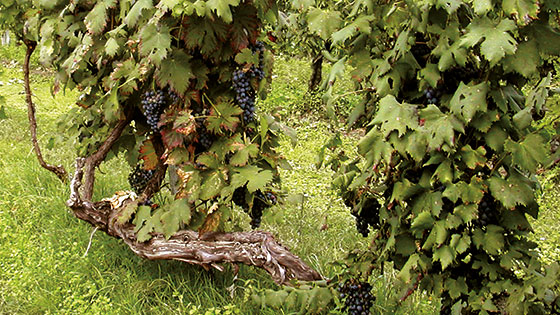HISTORICAL VINEYARD

Located in the Collevillano area in Faedis, the "historic" vineyard is a representation of Friulian viticulture, as intended almost 130 years ago. It was planted in 1896 by the Zani family, its owners to this day, thanks to the work of the brothers Eugenio and Cesare, who planted the vines that are still in production.
Their legacy went on to sons Giuseppe and Luigi and credit goes to current owner, Mr. Elvio Zani, son of Giuseppe, who kept the vineyard in the same conditions of the 30s and 40s, respecting its peculiarities and continuing the work together with his son Claudio.
PRESENTATION OF THE HISTORICAL VINEYARD
A SECULAR VINE OF REFOSCO DI FAEDIS

FEATURES
The vineyard stands on a plain, located on an alluvional substrate. The “fossai” (meaning the trenches) for planting the vines were dug by hand. The plants, raised with the inverted system, are placed individually along the rows; the support structure is made up of black locust and chestnut poles, placed at an average distance of four meters, and four metal wires.
The head posts are firmly reinforced with wooden counterpiles (“fronton” in Friulian), in a joint called “tap”. The ligatures of the shoots and vines are still carried out with wicker, and the old multiplication system by propagation is used: a branch is inserted into the ground, without detaching it from the mother plant, in order to stimulate the growth of roots.
In the historic vineyard, the vines stretch along the row in multiform contortions of the stem. This is because in the past the vine was respected, followed in its growth so rather than cutting it the winemaker bent it, twisted it, brought it back to the ground so as not to offend it with important cuts.
The four-meter distance between the rows was functional to the once widespread use of exploiting these large areas in the vineyards for the production of grass, to be used for zootechnical feeding.
GENETICS AND VINES
The historic vineyard is very interesting from the point of view of genetics, as at least 24 European vines are grown here. This great variety can be explained by the fact that once many of the local emigrants returning to their native country brought with them the typical vines of the places where they had gone to seek better luck and planted them, thus enriching the heterogeneity of the vines themselves.
In the past, when it was time for harvest, the white grapes and the black ones were collected separately and the wines that came from their pressing were "Nostran Blanc" and "Nostran Neri", the two classic historical Friulian wines.
The vines present in the vineyard are: Refosco di Faedis, Merlot, Verduzzo Giallo, Verduzzo Verde, Carmenère and Tocai as basic varieties and scattered vines of Refosco dal Peduncolo Rosso, Barzamino, Franconia, Isabella Nera, Courbeaux Noir, Vinoso nero, Cabernet Sauvignon, Nigrut, Picolit Nero, Spaccabotti, Ribolla Gialla, Aghedene, Siora, Picolit Bianco, plus some anonymous vines that have disappeared elsewhere.
The "Cuelvilan" vineyard is an important testimony that helps us understand how the old winemakers worked, how they carried out the countryside practices entirely by hand, with great sacrifices to respect the plant and the territory; it lets us understand the culture, history and energy that our past viticulture required. As a historic vineyard, it is a unique richness in the region for its age, its genetic composition, its shape and for its management.